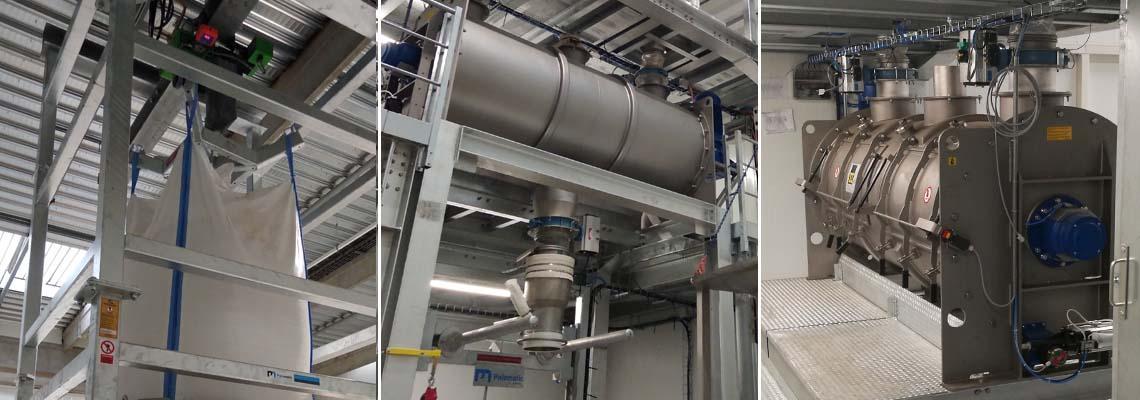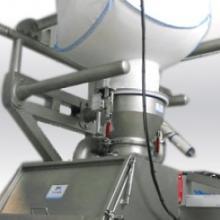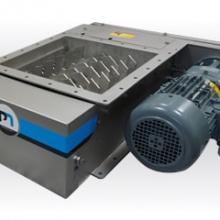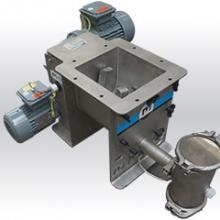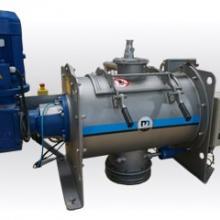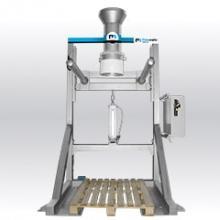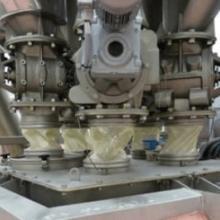Processed Materials: Granulated Sugar, Rebaudioside M, Cocoa Powder and various minor ingredients
Process for mixing dry ingredients
Objective: Our client, located in the Atlanta, GA metropolitan area, is a manufacturer of instant mix beverages, gelatins, vegan creamers, puddings, etc. The new facility expansion project required the capabilities of delivering bulk quantities of main ingredients with the flexibility of adapting to various recipes and allowing the introduction of minor ingredients. Delivery methods would require adapting the system to bulk bags, 50 lbs. sacks and pre-weighed manual introduction of powdered flavorings. Since particle coating of certain bulk ingredients were required, the prevention of particle attrition was also taken into consideration for this process design. All ingredients would need to be blended to produce a consistent mixture without the creation of additional fines, and then delivered to a bulk bag for re-packing and shipping to the client’s customers. The batch mixing size required was 1 bulk bag worth of mixed ingredients, or a working mixer capacity of 1 ton.
The Solution: Our team of powder handling experts designed a system that would allow for flexibility in the container types and methods the powered ingredients would be delivered. The industrial system design included bulk bag unloading stations with integrated bag dump stations, hand add dosing stations with screw feeders, a paddle mixer for with steam injection capabilities for gentle mixing action and particle coating, and a bulk bag filling station.
1. Duopal Bulk Bag and Sack Unloading Station
The client required two main ingredients for every recipe to be consistently delivered in 1 ton bulk bags. In addition, since the line needed to produce over 60 different recipes, bag dump stations were built into the bulk bag emptying units to save on cost and overall footprint of the bulk material unloading stations. This setup allows operators to both deliver a steady supply of the main ingredients, while also adapting to various recipes via 50 lbs. and 100 lbs. paper sacks.
The Palamatic Process Duopal station consists of two units that utilize electrical hoists with bulk bag hangers that allow the operator to attach the four corner handles for lifting and placing on the station. He can then attach the outlet spout of the bulk bag to a clamping plate to secure it in place.
The clamping plate consists of an inner out outer double jacketed tube that allows the channeling of material flow downstream while providing the air and dust exhaust for volume balancing. The entire assembly is on a flexible telescoping tube that can be raised or lowered for ergonomics, with the addition of material flow assistance. Once the spout is clamped, a pneumatic cylinder can lower the connecting spout causing a mild funneling effect at the bottom of the bulk bag. To further promote good flow from the FIBC, massage paddles are built into the sides of the station. The paddles are on pneumatic cylinders and help squeeze the sides of the super sack to break up any potential bridging or rat-holing issues.
Just below the untying box is the integrated sack tip tray. The operator opens the hinged access door and places the bag on the safety grid. He can then use a utility knife to cut the bag open and pour out the contents into the downstream process. All material contact surfaces are food grade design and made from 304 stainless steel. The entire station assembly is weighed with use of load cells. This allows the control panel to signal operators when the bulk bag is running low on material. It also creates lot traceability for recording material inputs, amounts used, dates, recipe information, etc.
On each bulk bag unloading station are integrated dust filters to contain and filter dust coming off the unloading points. Furthermore, the dust filters have discharge chutes that allow operators to reclaim product that would be otherwise lost to the filter cartridges. A compressed air tank is located on the exterior of the filter house at the top and is connected to several nozzles that send jets of air through the filter cartridges. In this manner the filters are kept clean and any loose dust is knocked back down through the chute and into the main material flow channel.
Because materials like granulated sugar tend to form lumps in bulk bags, lump breakers were chosen to be placed at the bottom discharge outlet of the bulk material stations. Lump breakers consist of a motor driven gearbox that rapidly rotates shafts with attached teeth or knives. When large lumps of material come into contact with the spinning knives, they are obliterated and returned to their free-flowing granular state. The installation if finished with a gravity rotary valve under the lump breaker to allow for material flow control and dosing action that is tied back into the load cell performance of the powder discharging station. Rotary valves use a VFD to control the rate at which they rotate. Inside the housing of the rotary valve are pockets divided by the rotor veins. As the rotor veins spin, the pockets are filled with the powder or granules and empty on the outlet side. Each pocket is a set capacity allowing for the metering and dosing of the ingredients.
For material amounts that are a very small percentage of the overall recipe to be mixed, the operators required a way to pre-weigh and add very accurate amounts to the mixer below. However, in order to save on time and improve ergonomics, a small dosing hopper was used to consistently supply the small amounts of material for that recipe batch.
The dosing hopper supplied a screw feeder that incorporates the use of load cells. Screw feeders are primarily used for productions that require small and accurate amounts of material in downstream processes. Common examples include powder milling equipment and powder mixers.
As the powder is dosed out of the hopper supply, the load cells tell the PLC the amount of weight that is being lost from the supply point (the dosing hopper). As we can see from both the bulk bag unloaders and the material screw feeders, this type of dosing method is often referred to as loss-in-weight (LIW). Considering the bulk density and flow characteristics of certain powders, it is possible to achieve a dosing accuracy of 5 grams. The operating principle is simple, material is extracted from the main storage chamber with use of a small auger that pushes the material down a horizontal tube attached to the main body.
The unit also uses an agitator driven by a secondary motor. This helps break up any flow issues and provides a consistent supply to the flow channel below. For the purpose of this project, we chose our D12 screw feeder that provides a theoretical flow rate of 524 liters per hour.
In order to assist the operator with faster cleaning times between recipe batches, our team of engineers designed an easy clean system that completely pulls the unit a part while all the weight of each modular component is supported on guide rails. The operator can disconnect the screw and agitator from the main housing and slide the assembly out and back with the motors still attached. This allows quick and easy access to all material contact points for complete clean down procedures.
3. Paddle Mixer
As mentioned earlier, the client wished to size the mixer capacity that would fill one bulk bag per blended recipe batch. Therefore, considering the varying material bulk densities, the mixer capacity was sized to a total volume of 1500 liters, or a maximum working volume of 1100 liters.
The paddle blending technology was chosen due to the aggressive, yet gentle mixing action of the paddle shaped medium. The Palamatic Process paddle mixer is ideal for mixing ingredients of different density & particle size as the paddle design “flings” the ingredients upwards with such velocity the mixing is done in the air, in a gravity free zone where density & size do not matter. The standard paddle mixer build consists of one motor, one gearbox, coupling, and shaft with paddle shaped attachments that impact with ingredients causing a multi directional movement that quickly blends the granules and powders.
The shaft is sealed with bushings & PTFE gland housing at both ends. Materials are loaded through the inlet flange at the top of the mixer body, and then discharged through the centered flanged outlet. Depending on production needs, the paddle mixer can be designed for either batch type or continuous processing.
The discharge can be customized with either a bolted flange type or Bombay style doors for full and fast emptying with no residual left over material. A custom feature for clean steam generation was added to the mixer to help with agglomeration effects as well as coating sugar particles with the addition of flavorings and artificial sweeteners. All internal components were polished to a 180 grit finish. The shaft was designed with cantilever technology to allow easy and quick access to the inside of the mixer for quick clean down between
4. Flowmatic 02 Bulk Bag Filling Station
To finish the mixing line and supply a full turnkey industrial solution, a super sack filling station was installed directly underneath the mixer discharge. The Palamatic Process Flowmatic series consists of a range of bulk bag loaders from simple and manual type of setup, semi-automated with pre-forming fans and vibrating densification tables, and fully automated with minimal operator intervention required. The Flowmatic® 02 model is a simple and mostly manual bulk material filling station. The bulk bag is hung on rounded forks and a pneumatic cylinder helps lift and gradually lower the bulk bag onto its handling pallet. An inflatable seal helps secure the bulk bag’s inlet spout to the industrial equipment and provides a dust tight connection. The width of the rounded bulk bag forks is manually adjustable to accommodate bulk bags of varying sizes.
A BFM flexible fitting was used between the mixer outlet and connection dock of the FIBC filler. This isolates the weight of the equipment and prevents interference with the load cells installed under the support feet of the bulk filling unit. By utilizing load cells on the material input stations and bulk packing output, the efficiencies of the operation can be closely monitored for guaranteed system accuracy. The goal was to fill a bulk bag of mixed food ingredients once every 15 minutes.
Palamatic Process has been supplying the powder and bulk solids industry with bulk material handling equipment since 1992. Our capabilities include original equipment manufacturing as well as system integration for turnkey solutions. In order to determine what solution is best for your project, contact one of our sales engineers. Together, our team of experts can provide the right kind of powder filling equipment that will fulfil your every production goal.
Contact one of our experts today for assistance with needed material handling solutions and to request a quote.














